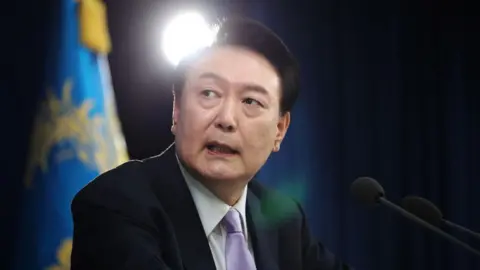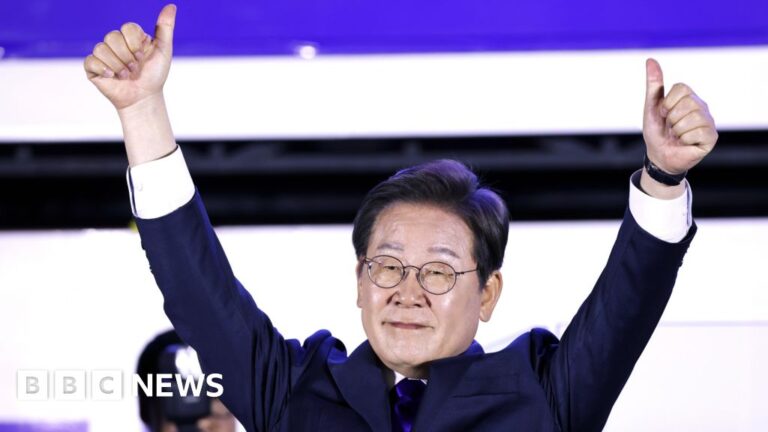British industry spared from Trump’s decision to double steel tariffs
Unlock the White House Watch newsletter for free
Your guide to what Trump’s second term means for Washington, business and the world
UK industry was on Tuesday exempted from a doubling of US steel and aluminium tariffs by Donald Trump, as British bosses urged Sir Keir Starmer to work quickly to implement a trade pact that would cut the levies to zero.
The surprise move by the Trump administration to hand Britain a carve-out from its latest tariff increases provided some respite for the prime minister, who is facing mounting frustration from industry over delays to implementing the US-UK trade accord.
Announcing the new tariffs via an executive order, Trump said the UK would escape a 50 per cent levy on steel and aluminium “to allow for the implementation of the US-UK Economic Prosperity Deal” — but British metal producers will contend with a 25 per cent tax until the pact takes effect.
Under the terms of the agreement, the UK will receive a zero-tariff quota for steel if it meets US security requirements to exclude China from its supply chains.
However, since the May 8 signing ceremony involving Starmer and Trump, negotiations over implementing the deal have dragged on.
Trump’s executive order added a note of jeopardy to the UK exemption, saying the president reserved the right to increase steel and aluminium tariffs on Britain to 50 per cent if “he determines that the United Kingdom has not complied with relevant aspects” of the trade deal.
The Trump administration’s decision to spare Britain came after UK business secretary Jonathan Reynolds held talks with his US counterpart Jamieson Greer in Paris on Tuesday, in a further effort to expedite the pact.
Reynolds said after the meeting that both sides were working to implement the agreement “as soon as possible” without specifying a timeline.
The UK government said in a statement: “We’re pleased that as a result of our agreement with the US, UK steel will not be subject to these additional tariffs.
“We will continue to work with the US to implement our agreement, which will see the 25 per cent US tariffs on steel removed.”
The trade pact also promised to reduce US tariffs on up to 100,000 British car exports from 25 per cent to 10 per cent.
Before Trump unveiled his executive order, Duncan Edwards, chief executive of BritishAmerican Business, a transatlantic trade body, said it was “very frustrating” from a British point of view that US tariffs on UK steel exports had not yet been cut to zero. Trump imposed 25 per cent tariffs on aluminium and steel imports in March.
Edwards said Starmer had slightly “oversold” the trade pact. “There’s a credibility issue when you say you have done it, but it’s not finished yet,” he added.
UK industry leaders showed growing signs of impatience earlier on Tuesday, telling parliament’s business and trade committee that it was urgent the trade accord was operationalised.
Russell Codling, director of markets business development at Tata Steel, which has steel making operations at Port Talbot in south Wales, said US tariffs of 25 per cent had already a “big impact” on the business, creating “huge levels of uncertainty” for the industry.
“My ‘ask’ is please can the government act as quickly as possible on this,” he told MPs.
The US is the UK’s second most important export market for steel, worth around £400mn a year.
UK carmakers are also in limbo, awaiting details on how they can qualify for a US export quota of 100,000 cars at a reduced 10 per cent tariff, and how it will be shared out.
Murray Paul, public affairs director at Jaguar Land Rover, said the company would continue hurting for as long as the UK government failed to conclude the negotiations on the trade pact.
“It comes down to speed. We are losing business rapidly — a complete cessation of activity with US customers and orders . . . I have confidence [in the deal], but it needs to happen, really, really quickly,” he added.
The hastily agreed trade pact announced by Starmer and Trump had an important disclaimer in the small print: “Both the United States and the United Kingdom recognise that this document does not constitute a legally binding agreement.”
British officials have been working to persuade the Trump administration to bring it into force, but some admitted there was no “clarity” about when this might happen.
The UK made concessions to the US side, agreeing 13,000 tonnes of beef and 1.4bn litres of bioethanol could be exported to the UK tariff free. Bioethanol is used to make the UK’s standard E10 petrol less carbon intensive.
US to scale back military presence in Syria, maintaining only one operational base | Updates on Syria’s Conflict
US envoy says Syria strategy ‘will not be like the last 100 years’ as troops pull out.
The United States will shut down most of its military bases in Syria, consolidating operations to a single location, as part of a policy overhaul announced by its new special envoy.
Thomas Barrack, appointed by President Donald Trump last month as the US ambassador to Turkiye and special envoy for Syria, said the shift marks a rejection of Washington’s past century of failed approaches in Syria.
In an interview with the Turkish broadcaster NTV on Monday, Barrack said the troop drawdown and base closures reflect a strategic recalibration.
“What I can assure you is that our current Syria policy will not be close to the Syria policy of the last 100 years because none of these have worked,” he said.
US forces are expected to withdraw from seven of eight bases, including those in Deir Az Zor province in eastern Syria, with remaining operations centred in Hasakah in the northeast.
Two security sources told the Reuters news agency that US military hardware and personnel have already started relocating. “All troops are being pulled from Deir Az Zor,” one source told Reuters in April.
A US Department of State official later said troop levels would be adjusted “if and when appropriate”, depending on operational demands.
Roughly 2,000 American soldiers remain in Syria, largely embedded with the Kurdish-led Syrian Democratic Forces (SDF), a key partner in the US-led campaign against ISIL (ISIS).
The SDF, dominated by the People’s Protection Units (YPG), a Kurdish militia, has been a longstanding point of contention with NATO ally Turkiye, which views it as linked to the outlawed Kurdistan Workers’ Party (PKK).
The PKK, which recently announced its disbandment, fought a decades-long armed rebellion against the Turkish state.
Barrack called the SDF “a very important factor” for the US Congress, stressing that integrating the group into Syria’s national army is now a priority. “Everyone needs to be reasonable in their expectations,” he said.
Since the ouster of Syrian President Bashar al-Assad in December, international engagement with Damascus has resumed under new President Ahmed al-Sharaa. Barrack recently raised the US flag over the ambassador’s residence in Damascus for the first time since 2012.
Turkish President Recep Tayyip Erdogan criticised the SDF last week, accusing it of “stalling tactics” despite its agreement to join the Syrian armed forces.
BRC Inc. Reveals Outcomes from Annual Stockholder Meeting

brc inc. announces results of annual stockholder meeting
South Korea presidency captured by Lee Jae-myung
Editor, BBC Korean
 EPA-EFE
EPA-EFESouth Korea has handed a decisive victory to opposition candidate Lee Jae-myung six months after his predecessor’s martial law bid failed.
The brief yet disastrous move set off huge protests and ended former president Yoon Suk Yeol’s career: impeached and removed from office, he still faces criminal charges for abusing his power.
But the political chaos that followed means victorious Lee’s biggest challenge is still ahead of him. He must unite a polarised country that is still reeling from it all.
He also faces challenges abroad – crucially, negotiating a trade deal with US President Donald Trump to soften the blow of tariffs from South Korea’s closest ally.
His main rival was the ruling party candidate and a former member of Yoon’s cabinet, Kim Moon-soo.
He had been trailing Lee for weeks in polls and in the early hours of Wednesday, he conceded defeat, congratulating Lee “on his victory”.
In an earlier speech, Lee had hinted at the win but stopped short of declaring it. He said “recovering” South Korea’s democracy would be his first priority.
The snap election comes just three years after the 61-year-old lost his last presidential bid by a razor-thin margin to Yoon.
It’s a remarkable comeback for a man who has been caught in several political scandals, from investigations over alleged corruption to family feuds.
Analysts say Lee’s win is also a rejection of the ruling People Power Party (PPP), which was tarred by Yoon’s martial law order.
“Voters weren’t necessarily expressing strong support for Lee’s agenda, rather they were responding to what they saw as a breakdown of democracy,” Park Sung-min, president of Min Consulting, told the BBC.
“The election became a vehicle for expressing outrage… [and] was a clear rebuke of the ruling party, which had been complicit in or directly responsible for the martial law measures.”
Lee’s win, he adds, shows that voters had put South Korea’s democracy “above all else”.
What lies ahead
Yoon’s departure also left his former party divided and in disarray, with infighting delaying the announcement of a presidential candidate until early May.
The chaos in the PPP went beyond just Yoon, as two acting presidents who followed were also impeached, before one of them was reinstated – a sign of how contentious South Korean politics had become.
All of this certainly helped the opposition Democratic Party and its candidate Lee, who signalled more stability.
But while he has won the election, his challenges are far from over.
He faces a trial in the Supreme Court over charges of violating the election law. The court postponed the trial until after the election to avoid interference because a conviction could have barred him from contesting.
But it’s not clear what happens if Lee is now found guilty, though the law says sitting presidents cannot be prosecuted for criminal offences, with the exception of insurrection or treason.
Lee has had a controversial career in which he has built a loyal base but he has also drawn disapproval and ire for what some have called an abrasive style.
He has spoken openly of a tough childhood in a working class family, before he went to college and became a human rights lawyer.
He then switched to a political career, making his way up the DP until – in 2022 – he became their presidential candidate. He campaigned on a more liberal platform, promising to address gender inequality, for instance.
But after he lost the vote, he pivoted, opting this time to move more toward the centre and play it safer with his policies.
 Getty Images
Getty ImagesIn office, he will also need to reach across the aisle and work with the PPP, a party he battled regularly during Yoon’s term. But he may need some of them to work with him to rebuild public trust and mend a fractured country.
“Years of escalating polarisation under both the [previous] Moon and Yoon administrations have left South Korea’s political landscape bitterly divided,” Mr Park said.
“Lee may speak of national unity, but he faces a profound dilemma: how to pursue accountability for what many view as an attempted insurrection without deepening the very divisions he seeks to heal.”
Despite the PPP’s loss, Yoon still has a considerably strong and vocal support base – and they are unlikely to go away anytime soon.
His supporters, mainly young male voters and the elderly, often echo strong right-wing narratives and many of them believe his declaration of martial law was necessary to protect the country.
Many also peddle conspiracy theories, believing Yoon’s party was a victim of election fraud.
Thousands protested against his impeachment and in January, shortly after his arrest, a pro-Yoon crowd stormed a courthouse and assaulted police officers.
With Yoon gone, there are questions about who might fill that vacuum for his base.
 Getty Images
Getty ImagesOne name in particular has emerged: Lee Jun Seok, who also ran for president, but dropped out earlier on Tuesday, when exit polls suggested he was trailing too far behind, with just 7.7% of the votes.
Still, he has been especially popular with many young men for his anti-feminist views, which has reminded some of Yoon, under whom equality for women became a polarising subject.
Young men in their 30s came out in higher numbers than usual to vote this time, drawn in part by candidates like Lee Jun-seok. Those wanting to hold the PPP-led government accountable, and others wanting to ensure Lee Jae-myung’s presidency was dashed, led to this year’s voter turnout reaching 79.4% – the highest since 1997.
However, it is not just healing these divides at home that will keep Lee busy in the immediate future. He also faces urgent challenges abroad, such as navigating the US-Korea alliance under the new Trump administration.
“South Korea’s pressing domestic challenges are increasingly intertwined with global dynamics,” Mr Park said, adding that it has implications for the country’s economy and defence, given that the US is both a crucial trading partner and security ally.
A trade deal with the US is top of the agenda, he said, with sluggish demand and slowing growth already hurting the economy.
Lee – a seasoned politician – goes into office knowing all of this, and in the early hours made a promise to South Korea’s voters.
“I will do my utmost to fulfil the great responsibility and mission entrusted to me, so as not to disappoint the expectations of our people,” Lee told reporters.
Elon Musk criticizes Trump’s extravagant spending plan as ‘outrageous’ and ‘disgusting’
© 2025 Fortune Media IP Limited. All Rights Reserved. Use of this site constitutes acceptance of our Terms of Use and Privacy Policy | CA Notice at Collection and Privacy Notice | Do Not Sell/Share My Personal Information
FORTUNE is a trademark of Fortune Media IP Limited, registered in the U.S. and other countries. FORTUNE may receive compensation for some links to products and services on this website. Offers may be subject to change without notice.
Dan Meinholz, CEO of A3 Performance, explains the innovative new swim technology.
A3 Performance is making a bold leap forward this summer with the upcoming launch of its most advanced tech suit yet: PRANA. Founder and CEO Dan Meinholz shared the big picture in an exclusive conversation with SwimSwam, walking us through the inspiration, innovation, and athlete-focused engineering behind this world-class race suit.

 PRANA Swim Tech Launches July
PRANA Swim Tech Launches July
PRANA—named for the Sanskrit word meaning “life force”—isn’t just about materials or seams. It’s a mindset. Designed to unify the mental and physical elements of elite racing, PRANA is engineered to help athletes unlock the elusive flow state where peak performance lives. And from what we’ve heard, early athlete feedback confirms it delivers.
The suit blends structural compression with complete freedom of movement, encouraging swimmers to stay tuned into their stroke mechanics and adjust in real-time for maximum efficiency and power. That synergy of mind and body? It’s baked into every thread.
Innovation Highlights
-
First-Ever Single-Layer Tech Suit: A market first—PRANA ditches the internal lining used by every other suit on the market. The result? Greater durability, less water absorption, and a suit that compresses and breathes.
-
Nanoseal HydroBond Technology: A3’s proprietary, PFC-free DWR coating doesn’t just sit on the surface. It penetrates every fiber—like the waxy coat of a seabird—to repel water, reduce drag, and keep the suit lightning fast across multiple races.
-
Built to Last: With a dense weave and a compression rating up to 20% higher than traditional suits, PRANA retains its performance edge over time—meaning fewer replacements and more value for swimmers and teams.
With the July launch around the corner, PRANA is positioning itself not just as another suit—but as the next evolution in competitive swimwear.
Stay tuned as we go deeper with Dan Meinholz on what this suit means for the future of racing—and how PRANA might just help you tap into your own limitless potential.
Order PRANA in July here.




In the SwimSwam Podcast dive deeper into the sport you love with insider conversations about swimming. Hosted by Coleman Hodges and Gold Medal Mel Stewart, SwimSwam welcomes both the biggest names in swimming that you already know, and rising stars that you need to get to know, as we break down the past, present, and future of aquatic sports.
Music: Otis McDonald
www.otismacmusic.com
Opinions, beliefs and viewpoints of the interviewed guests do not necessarily reflect the opinions, beliefs, and viewpoints of the hosts, SwimSwam Partners, LLC and/or SwimSwam advertising partners
A3 Performance has been a SwimSwam partner for over ten years.
Virus Detection Revolutionized with Bioluminescence Breakthrough
Animals that produce their own light source, through an internal chemical reaction, are one of the many wonders of nature – and something biotechnology scientists have been working hard to replicate and adapt for human use for some time.
Now, researchers at Mass General Brigham have made a breakthrough by mixing up the recipe for that chemical reaction, creating a bioluminescence diagnostic tool that’s 515 times brighter and eight times more enduring than current models. It isn’t just brighter, but retains most of its glow – 96% of it – after an hour, which leapfrogs the hurdles faced by existing tools.
Called Luminescence CAscade-based Sensor (LUCAS), this tool uses the natural “ingredients” in the production of bioluminescence – the light-emitting molecule luciferin, which reacts with the enzyme luciferase. Traditionally, replicating nature’s glow has worked, to a point. Scientists have been able to produce this reaction but have been unable to sustain the glow for long. LUCAS, however, also features an enzyme known as beta-galactosidase, which attaches to luciferin and regulates the release of its light-emitting properties.
As such, the tool is not just significantly stronger but enduring, allowing for an efficient way to detect and light up hard-to-find virus particles with a single reaction.
“Developing effective diagnostics is incredibly challenging, especially when you think about the size of infectious disease particles and the complicated biological fluids we’re attempting to identify them in,” said senior author Hadi Shafieee, a researcher at Brigham and Women’s Hospital. “Finding an HIV particle in a human blood sample is like finding an ice cube in a jelly-filled Olympic swimming pool while blindfolded. With its novel enzyme cascade approach, LUCAS marks a substantial leap forward for sensing viruses in these complex biological samples.”
The researchers tested the new tool against 177 viral-spiked patient samples and 130 viral-spiked serum samples infected with a range of pathogens – SARS-CoV-2, HIV, HBV, or HCV. Samples of what we know as COVID-19 were gathered via nasal swab, while the others through bloodwork. Incredibly, LUCAS was able to help scientists determine the virus within 23 minutes, and had an accuracy rate that averaged more than 94% across all infections.
Buoyed by the breakthrough, the researchers will now enlist LUCAS to detect pathogens in other biological fluids, as well as test whether it can identify multiple viruses in a single sample. And the team says the tool – which is designed to be portable and easy to use – could be adapted to identify other disease biomarkers, such as the ones we know of for Alzheimer’s.
“We always want to detect infection and disease as early as possible, as that can make all the difference when it comes to care and long-term outcomes,” said first author Sungwan Kim, a postdoctoral researcher in Shafiee’s lab. “With our focus on developing diagnostic tools that are sensitive, accurate, and accessible, we want to make early detection easier than it has ever been and push personalized care into a new era.”
The study was published in the journal Nature Biomedical Engineering.
Source: Mass General Brigham
Map: Turkey Hit by 5.8-Magnitude Earthquake
Note: Map shows the area with a shake intensity of 4 or greater, which U.S.G.S. defines as “light,” though the earthquake may be felt outside the areas shown. The New York Times
A moderately strong, 5.8-magnitude earthquake struck in Turkey on Tuesday, according to the United States Geological Survey.
The temblor happened at 2:17 a.m. Eastern European time about 3 miles south of İçmeler, Turkey, data from the agency shows.
As seismologists review available data, they may revise the earthquake’s reported magnitude. Additional information collected about the earthquake may also prompt U.S.G.S. scientists to update the shake-severity map.
Source: United States Geological Survey | Notes: Shaking categories are based on the Modified Mercalli Intensity scale. When aftershock data is available, the corresponding maps and charts include earthquakes within 100 miles and seven days of the initial quake. All times above are Eastern European time. Shake data is as of Monday, June 2 at 7:34 p.m. Eastern. Aftershocks data is as of Tuesday, June 3 at 12:02 p.m. Eastern.
Maps: Daylight (urban areas); MapLibre (map rendering); Natural Earth (roads, labels, terrain); Protomaps (map tiles)
Tony Latham, a seasoned music industry professional, introduces Royalty Access Studio and commits to providing $20 million in artist financing within the next year.
Tony Latham, a music industry veteran, has founded Royalty Access Studio (RAS), a platform to provide advances against future royalty payments to artists and songwriters worldwide.
UK-based RAS said it has secured committed capital of at least USD $20 million to deploy over the next 12 months.
Latham previously served as chief financial officer at Wise Music Group and finance director at performer rights organization PPL PRS.
He also served as vice president of investor services at music tech company Utopia, focusing on catalog acquisitions and fund monetization strategies.
Additionally, Latham serves as a Trustee of UK charity Orchestras Live, which brings live classical music to communities across the UK, regardless of their background.
Latham’s new project promises “transparent and ethical alternative to traditional royalty financing, with a streamlined application process, no credit checks, and straightforward documentation.”
Additionally, the company operates what it calls a “non-acquisitive” model, meaning, according to the company, that “artists and writers retain full ownership and control of their rights while unlocking capital based on future earnings”.
Tony Latham, Co-Founder and CEO of Royalty Access Studio, said: “We launched RAS to make royalty advances simple.
“After two decades in senior roles across the music industry, I’ve seen how difficult it can be for artists and songwriters to access funding that truly supports their interests. We’re here to support them in a fair and transparent way. Our model is built on trust, flexibility, and clarity – with creators at the centre of every deal.”
“After two decades in senior roles across the music industry, I’ve seen how difficult it can be for artists and songwriters to access funding that truly supports their interests. We’re here to support them in a fair and transparent way.”
Tony Latham, Royalty Access Studio
Latham’s company targets deals ranging from $10,000 to seven-figure amounts, he said.
“We want to be the most approachable, flexible partner in this space,” added Latham. “Whether it’s a $10,000 top-up or a seven-figure consolidation, we treat every deal with care. Artists and writers deserve straightforward access to their income without unnecessary complexity or barriers.”
The launch of Latham’s new project comes amid the growing music royalty advance market as artists seek alternatives to traditional record label financing.
beatBread reported in February that it had paid advances to over 1,300 clients on six continents to date on existing catalogs as well as new and unreleased music. The platform’s funding amounts range from $1,000 to over $10 million.
Music Business Worldwide










